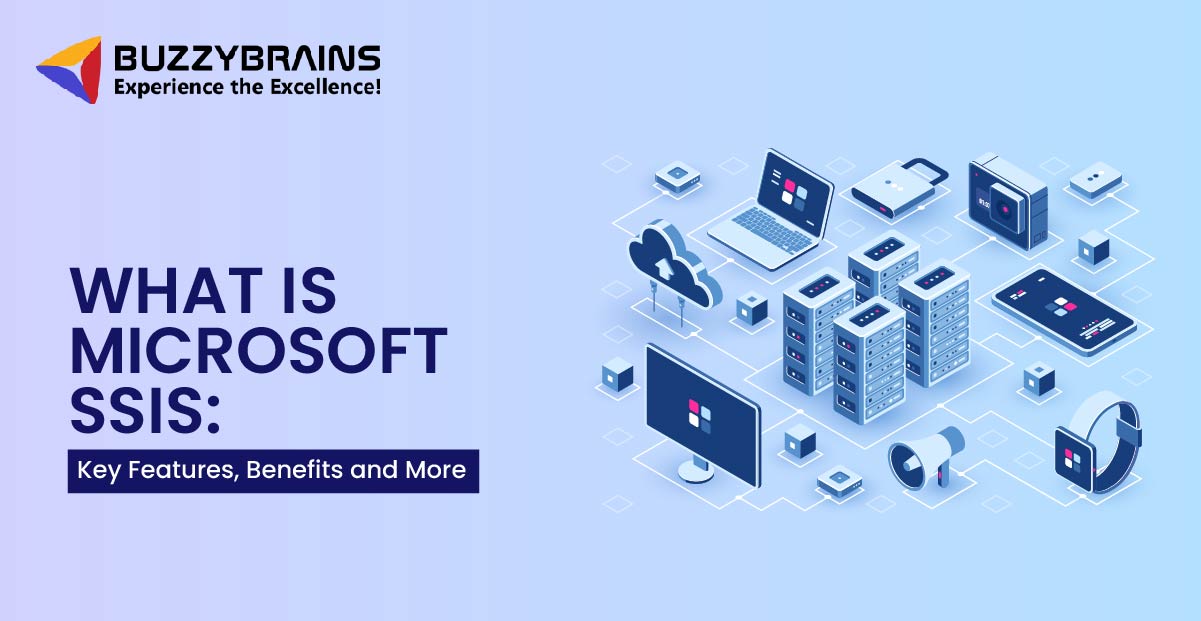What is Microsoft SSIS: Key Features, Benefits and More

In the ever-evolving world of data management, organizations constantly seek robust solutions to handle their data integration and transformation needs. Microsoft SQL Server Integration Services (SSIS) stands out as a powerful ETL (Extract, Transform, Load) tool designed to help businesses efficiently manage data workflows. SSIS offers a comprehensive suite of features that simplify complex data tasks, making it a go-to choice for many organizations. In this blog, we’ll explore what Microsoft SSIS is, its key features, benefits, common challenges, use cases, and more.
- What is Microsoft SSIS?
- Key Features of Microsoft SSIS
- How Does Microsoft SSIS Work?
- Benefits of Using Microsoft SSIS
- Common Challenges and Solutions with Microsoft SSIS
- Common Use Cases for Microsoft SSIS
- FAQs about Microsoft SSIS
- Conclusion
- Streamline Your Data Integration with BuzzyBrains - Your SSIS Experts
What is Microsoft SSIS?
Microsoft SQL Server Integration Services (SSIS) is a component of the Microsoft SQL Server database software, specifically designed to perform data integration and workflow automation tasks. SSIS enables organizations to extract data from various sources, transform it into the desired format, and load it into destination systems like databases, data warehouses, or even cloud platforms. It provides a graphical user interface for designing complex workflows, making it accessible to both developers and data professionals.
Introduced as part of SQL Server 2005, SSIS replaced the earlier Data Transformation Services (DTS). Over the years, SSIS has evolved significantly, adding new features and capabilities to meet the growing demands of data integration in modern enterprises. Today, SSIS is a critical component of Microsoft’s data platform, widely used for building data warehouses, migrating data, and automating various data-related tasks.
Related Blog: What is Snowflake Tool? A Complete Guide to Snowflake Data Platform
Key Features of Microsoft SSIS
Microsoft SSIS is packed with features that make it a versatile and powerful ETL tool. Here are some of the key features:
- Drag-and-Drop Interface: A user-friendly, drag-and-drop interface for creating ETL workflows without extensive coding.
- Data Transformation Capabilities: A wide range of transformations, including data cleansing, aggregation, and data type conversion.
- Connectivity and Integration: Supports integration with various data sources like SQL Server, Oracle, Excel, XML, and flat files.
- Error Handling and Logging: Built-in error handling, event logging, and debugging tools for monitoring and troubleshooting ETL processes.
- Scalability and Performance: Capable of handling large volumes of data with features like parallel processing and incremental load.
- Custom Scripting: Support for custom scripts written in C# or VB.NET to extend the functionality of SSIS packages.
- Data Warehousing Support: Features tailored for data warehousing, such as slowly changing dimensions (SCD) and data partitioning.
- Automation and Scheduling: Integration with SQL Server Agent for automating ETL processes and scheduling jobs.
- Data Quality Tools: Includes tools for ensuring data quality, such as data profiling and data validation.
How Does Microsoft SSIS Work?
Microsoft SSIS operates through a combination of packages, control flows, data flows, and other components that work together to perform data integration tasks. Here’s a breakdown of how SSIS works:
1. SSIS Packages
An SSIS package is a collection of tasks, control flows, data flows, variables, and configurations that define the ETL process. Each package can be designed to perform a specific data task, such as extracting data from a source, transforming the data, and loading it into a destination. Packages are the core units of work in SSIS, and they can be developed, tested, and deployed independently.
2. Control Flow
The control flow in SSIS defines the sequence in which tasks are executed within a package. It includes tasks like executing SQL queries, sending emails, and processing data. Control flow tasks can be connected with precedence constraints, which dictate the order of execution based on success, failure, or completion of previous tasks.
3. Data Flow
The data flow is where the actual data transformation takes place. It involves extracting data from sources, applying transformations (e.g., filtering, sorting, aggregating), and loading the transformed data into destinations. The data flow includes various components like sources, transformations, and destinations, all of which are linked together to create a data processing pipeline.
4. Variables and Parameters
SSIS allows the use of variables and parameters to make packages dynamic and flexible. Variables can store values that change during package execution, while parameters can be used to pass values into a package at runtime. This feature is particularly useful for reusing packages in different environments or scenarios.
5. Event Handling and Logging
SSIS includes robust event handling and logging capabilities that help monitor package execution and troubleshoot issues. Event handlers can be defined to respond to specific events, such as errors or warnings, during package execution. Additionally, SSIS provides detailed logging options, allowing users to capture information about package execution, errors, and performance.
Benefits of Using Microsoft SSIS
Using Microsoft SSIS offers several advantages that make it a preferred choice for data integration and ETL processes. Here are some of the key benefits:
- Cost Efficiency: As part of the SQL Server suite, SSIS is cost-effective for organizations already using Microsoft products, eliminating the need for additional ETL tools.
- Ease of Use: The drag-and-drop interface and pre-built components simplify the process of designing and implementing ETL workflows, reducing the learning curve for new users.
- Integration with Microsoft Ecosystem: SSIS seamlessly integrates with other Microsoft products, including SQL Server, Azure, Power BI, and Excel, enabling end-to-end data solutions.
- Scalability: SSIS can handle both small and large-scale ETL processes, making it suitable for organizations of all sizes. It supports parallel processing and can be scaled to meet increasing data demands.
- Flexibility: SSIS offers extensive customization options through scripting, third-party components, and integration with various data sources and destinations.
- Comprehensive Data Handling: With its wide range of data transformation and cleansing capabilities, SSIS can handle complex data processing tasks, ensuring data quality and consistency.
- Security: SSIS includes robust security features, such as encryption, role-based access control, and secure storage of sensitive data, ensuring compliance with industry standards.
Common Challenges and Solutions with Microsoft SSIS
While Microsoft SSIS is a powerful tool, it’s not without its challenges. Here are some common challenges users may encounter and how to overcome them:
1. Performance Tuning:
As data volumes grow, SSIS packages may experience performance bottlenecks.
Solution: Optimize performance by using parallel processing, efficient data flow design, and leveraging the appropriate transformations. Regularly monitor and tune package performance using SSIS’s built-in profiling and logging tools.
2. Data Source Connectivity Issues:
Connecting to various data sources can sometimes lead to compatibility or configuration issues.
Solution: Ensure that the correct drivers and permissions are in place for all data sources. Use connection managers and test connectivity during the package development phase.
3. Error Handling in Complex Workflows:
Managing errors in complex ETL workflows can be challenging, especially when dealing with multiple data sources and transformations.
Solution: Implement robust error handling strategies, such as using event handlers, logging errors, and employing retry logic. Utilize SSIS’s built-in debugging tools to identify and resolve issues during development.
4. Package Deployment and Management:
Deploying and managing SSIS packages across different environments can be complex, especially in large organizations.
Solution: Use SSIS’s deployment tools and environments feature to manage package deployment. Consider using SQL Server Integration Services Catalog (SSISDB) for centralized management and monitoring of SSIS packages.
Common Use Cases for Microsoft SSIS
Microsoft SSIS is versatile and can be applied to a wide range of data-related tasks. Here are some common use cases:
1. Data Migration
SSIS is often used for migrating data from legacy systems to modern databases. Its ability to connect to various data sources and perform complex transformations makes it ideal for data migration projects.
2. Data Warehousing
SSIS plays a crucial role in loading, transforming, and aggregating data for data warehousing. It can handle large volumes of data, ensuring that data warehouses are populated with clean, accurate, and consistent data.
3. Data Integration
Organizations use SSIS to integrate data from multiple sources into a single system for analysis and reporting. This integration capability is essential for businesses that need to consolidate data from various departments or systems.
4. Data Cleansing
SSIS includes tools for identifying and correcting data quality issues during the ETL process. This ensures that the data loaded into the destination systems is accurate, consistent, and reliable.
5. Master Data Management (MDM)
SSIS can be used in MDM projects to ensure that master data is consistent, accurate, and up-to-date across different systems. It helps maintain a single source of truth for critical business data.
6. Business Intelligence (BI)
SSIS is often used to feed clean, transformed data into BI tools like Power BI for advanced analytics and reporting. This enables organizations to gain insights from their data and make informed decisions.
FAQs about Microsoft SSIS
Q1. What versions of SQL Server include SSIS?
SSIS is included with SQL Server Standard, Enterprise, and Developer editions. Each edition offers different levels of functionality, with the Enterprise edition providing the most advanced features.
Q2. Can SSIS integrate with cloud data sources like Azure or AWS?
Yes, SSIS can integrate with various cloud data sources, including Azure and AWS. Microsoft provides specific components and connectors for these cloud platforms, enabling seamless integration and data movement.
Q3. How does SSIS handle real-time data integration?
SSIS primarily focuses on batch processing, but it can handle near-real-time data integration using tools like Change Data Capture (CDC) or by integrating with streaming technologies. For true real-time integration, other tools like Azure Stream Analytics may be more appropriate.
Q4. Is SSIS suitable for large-scale ETL projects?
Yes, SSIS is highly scalable and can handle large-scale ETL projects. Its ability to process large volumes of data efficiently, combined with its support for parallel processing, makes it suitable for complex, enterprise-level data integration tasks.
Q5. What are the licensing requirements for SSIS?
SSIS is licensed as part of SQL Server, so organizations need to purchase the appropriate SQL Server edition that includes SSIS. The cost will depend on the edition (Standard, Enterprise, or Developer) and the licensing model (per-core or server/CAL).
Conclusion
Microsoft SSIS is a powerful, flexible, and scalable ETL tool that offers a wide range of features for data integration, transformation, and automation. Its seamless integration with the Microsoft ecosystem, combined with its ease of use and robust performance capabilities, makes it an ideal choice for organizations looking to streamline their data workflows. By understanding the key features, benefits, and common challenges of SSIS, businesses can fully leverage this tool to meet their data management needs.
Streamline Your Data Integration with BuzzyBrains – Your SSIS Experts
At BuzzyBrains, we specialize in helping businesses unlock the full potential of Microsoft SSIS for their data integration needs. Whether you’re just getting started with SSIS or looking to optimize your existing workflows, our team of experts is here to guide you every step of the way. Contact us today to learn how we can help you streamline your data integration processes and achieve your business goals with SSIS.

